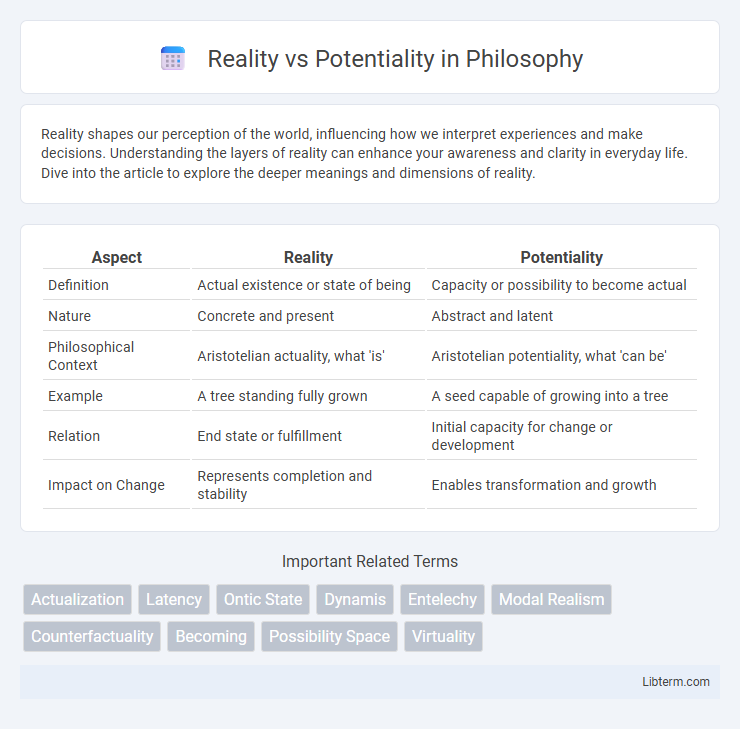Reality shapes our perception of the world, influencing how we interpret experiences and make decisions. Understanding the layers of reality can enhance your awareness and clarity in everyday life. Dive into the article to explore the deeper meanings and dimensions of reality.
Table of Comparison
| Aspect | Reality | Potentiality |
|---|---|---|
| Definition | Actual existence or state of being | Capacity or possibility to become actual |
| Nature | Concrete and present | Abstract and latent |
| Philosophical Context | Aristotelian actuality, what 'is' | Aristotelian potentiality, what 'can be' |
| Example | A tree standing fully grown | A seed capable of growing into a tree |
| Relation | End state or fulfillment | Initial capacity for change or development |
| Impact on Change | Represents completion and stability | Enables transformation and growth |
Understanding Reality: Definitions and Perspectives
Reality, defined as the state of things as they actually exist, encompasses both physical phenomena and experiential truths validated through empirical observation and logical analysis. Philosophical perspectives on reality vary from metaphysical realism, which asserts that reality exists independently of perception, to constructivist views that emphasize the role of cognitive frameworks in shaping our understanding. Understanding reality involves distinguishing it from potentiality, where potentiality refers to the capacity for change or development that is not yet actualized in the present state.
What is Potentiality? Exploring Possibilities
Potentiality refers to the inherent capacity or possibility within an entity to develop, change, or achieve something under the right conditions. It represents the untapped or latent qualities that can be actualized through growth, effort, or external influences. Exploring possibilities involves recognizing these dormant capabilities and envisioning various outcomes that could emerge as potentiality unfolds into reality.
The Interplay Between Reality and Potentiality
Reality and potentiality represent two fundamental states influencing human behavior and decision-making processes. The interplay between them drives innovation, as potentiality embodies latent possibilities that, when actualized, reshape existing realities. Recognizing this dynamic facilitates strategic planning and adaptive growth in complex systems.
Philosophical Foundations: Reality vs Potentiality
Reality, in philosophical foundations, is defined as the state of things as they actually exist, encompassing all that is present and observable. Potentiality refers to the inherent capacity or possibility within an entity to develop or change into a different state. Aristotle's metaphysics fundamentally contrasts actual reality (entelecheia) with potentiality (dunamis), emphasizing the dynamic process through which potential states actualize into concrete realities.
Real-Life Examples: When Potential Meets Reality
A young athlete with raw talent (potentiality) becomes a professional player through rigorous training and discipline (reality). A startup's innovative idea (potentiality) materializes into a successful company after strategic planning and market execution (reality). An artist's imaginative concept (potentiality) transforms into a masterpiece through skillful techniques and persistence (reality).
Limiting Factors: Why Potential Stays Untapped
Limiting factors such as fear of failure, lack of resources, and inadequate skills prevent potential from being fully realized. External constraints including social environment and economic conditions also restrict the translation of potential into reality. Overcoming these barriers requires targeted strategies like skill development, resource allocation, and supportive networks to unlock true capability.
Unlocking Potential: Strategies and Mindsets
Unlocking potential requires embracing a growth mindset that views challenges as opportunities for development rather than obstacles. Implementing strategic goal-setting and consistent self-reflection enables individuals to bridge the gap between current reality and future capabilities. Neuroplasticity studies support that deliberate practice and resilience are key factors in transforming latent abilities into tangible achievements.
Reality Checks: Balancing Dreams and Practicality
Reality checks serve as essential tools for balancing dreams and practicality by grounding ambitious goals in achievable steps. Evaluating current resources, limitations, and market conditions ensures that potentiality aligns with real-world constraints, guiding informed decision-making. This balance prevents unrealistic expectations while fostering strategic growth rooted in tangible progress.
Potentiality in Personal Growth and Success
Potentiality in personal growth and success represents the untapped capabilities and inherent qualities within an individual that can be cultivated over time. Recognizing and harnessing potentiality drives motivation, fosters skill development, and creates pathways for achieving long-term goals. Emphasizing continuous learning and self-improvement transforms latent potential into measurable achievements and sustainable progress.
Bridging the Gap: Turning Potential into Reality
Bridging the gap between reality and potentiality requires strategic goal setting and consistent action plans that translate latent abilities into tangible achievements. Leveraging cognitive tools such as visualization and feedback loops enhances motivation and tracks progress effectively. Organizations and individuals maximize outcomes by aligning resources and skills with measurable objectives, transforming abstract possibilities into concrete results.
Reality Infographic

 libterm.com
libterm.com